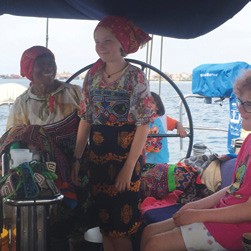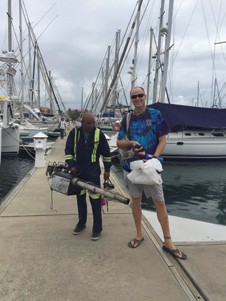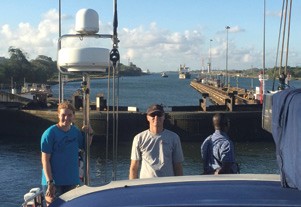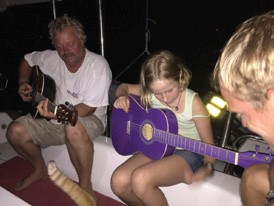By Colin Rath
Editor’s note: This is the thirteenth installment in a series of dispatches from the Rath family (Colin & Pam, daughters Breana, Mariel and Nerina), who departed Stamford, CT in the fall of 2014 for a worldwide cruise aboard their Hanse 545 Persevere. You’ll find previous articles linked below.
 The San Blas Islands, located in the Caribbean off the northern coast of Panama, are a paradise from a lost time. They consist of 400 cays that are the property of the Kuna Indians. The Kuna only actually inhabit 49 of the islands, so you can find your own unpopulated oasis pretty much everywhere. These are beautiful islands, but treacherous since there are encircled with reefs everywhere that aren’t particularly well represented on the charts, which meant that Breana and Pam spent a lot of time on the bow, yelling directions based on what they could see in the crystal clear water…which is always fun when you draw 9 feet.
The San Blas Islands, located in the Caribbean off the northern coast of Panama, are a paradise from a lost time. They consist of 400 cays that are the property of the Kuna Indians. The Kuna only actually inhabit 49 of the islands, so you can find your own unpopulated oasis pretty much everywhere. These are beautiful islands, but treacherous since there are encircled with reefs everywhere that aren’t particularly well represented on the charts, which meant that Breana and Pam spent a lot of time on the bow, yelling directions based on what they could see in the crystal clear water…which is always fun when you draw 9 feet.
The girls enjoyed trying on colorful Kuna dresses in the San Blas Islands. © persevere60545.com
It’s also suggested that you don’t go too far inland on these isolated, deserted islands since smugglers often use them for contraband caches, and those are folks you don’t want to run into unexpectedly on a deserted island. The islands are also covered with insects, and even drenched with OFF! we could only last a few hours ashore before being eaten alive.
Other than that we loved the islands, and spent two weeks discovering and claiming our own cays. We only saw three other boats the first week, and not many more until we came across vacation spots as we cruised further down the chain. We enjoyed our days snorkeling, diving and spear fishing after the girls finished school each day. Lobsters were abundant on the reefs, so seafood was the full diet and life was good. After a few days, a local Kuna canoed by and charged us $10 for a month of anchoring in the islands.
Eventually, we had to check into Panama. That’s a lot easier to do in a remote area where with customs and immigration are in the same building, rather than searching for two different offices spread out all over town. So, we went to the island of El Porvenir, which are actually three small islands. One island has the government offices, a small hotel and an airstrip, and the two others are overpopulated with thatch roof huts for 500 families and cement block stores. Several canoes full of families came out to greet us and sell us their wares as we dropped anchor. They have fresh fish, lobsters, intricate hand-stitched native artwork called Molas, traditional clothes, and beads. They hopped up on the boat, spread their goods out all over the cockpit, and the store was open. The girls had a blast trying on Kuna dresses.
We befriended Lester, and were invited ashore to meet his family and explore his village. It was like being back in the Stone Age, with bits of modern technology everywhere: bamboo huts with thatch roofs and dirt floors, whole families living in a 200 square foot space, sleeping in hammocks, with a TV in the corner covered in tarps so it doesn’t get wet.
Water is from a faucet in the town square next to the basketball court. Basketball is the Kuna’s national pastime, which is interesting because the Kuna are not particularly tall. They have annual inter-island tournaments, with the championship in El Porvenir. Lester proudly showed us the island’s trophy room, which had 50 or so life-size trophies that his island had won over the years. He showed us around the island and we met his huge family (20 plus). We stayed there for two days to get our Zarpe (departure clearance) done so that we could enter Colon, Panama without a problem and start the canal procedures.
 Shelter Bay Marina is on the old American Base for the Panama Canal, just outside Colon. The U.S. gave the Canal to Panama, and the base is now ransacked and deserted. I think the Panamanian Army use it for war games now. The marina is a good place for preparing for passage through the Panama Canal and obtaining certification for Galapagos. Colon and Panama City are good places to provision up and that’s advisable because cruisers will not see another reasonable supermarket until making landfall in Marquesas (about 60 days later).
Shelter Bay Marina is on the old American Base for the Panama Canal, just outside Colon. The U.S. gave the Canal to Panama, and the base is now ransacked and deserted. I think the Panamanian Army use it for war games now. The marina is a good place for preparing for passage through the Panama Canal and obtaining certification for Galapagos. Colon and Panama City are good places to provision up and that’s advisable because cruisers will not see another reasonable supermarket until making landfall in Marquesas (about 60 days later).
All cruising yachts must be fumigated before making landfall in the Galapagos. © persevere60545.com
We also had to get the boat measured, clean the bottom, rent fenders and hire rope handlers for transiting the canal, and fumigate the boat. This is a good one, 30 days out of the Galapagos, you have to hire this company whose owner is related to the Chairman of the Galapagos Department of Tourism to fumigate your boat for bugs… right. A guy shows up, looking like a Ghostbusters character and smokes out your boat. Once he leaves, you air out your boat and you get a certificate to enter Galapagos.
You also have to schedule an advisor from the Panama Canal Authority to accompany you aboard for the two-day trip through the locks. The advisors are tugboat captains for the canal, who are hired out on their off time for extra money. There are three ways your boat can pass through the locks. One is being tied to one of the lock walls while the lock is being filled and drained (Bad idea for any cruising boat – your boat will be destroyed). The second is being tied up to two other cruising boats as you go through the lock (This is better – you have boats and fenders on both sides and their rope handlers do most of the work). This is what we did when we made passage through the canal. Finally, you can opt to be alone and set in the middle of the lock, which is safest, but that option is usually not available since the canal only makes money when each lock is filled with ships. Plus realize, this is just cruising boats – a container ship will also be in the lock with you, taking up the other 800 feet and using his engines to exit the lock ahead of you, giving you a little turbulence in the water.
We were scheduled to go through the canal on April 10, but there was a small strike and we were delayed until April 14, so we rented a car and set off to discover Panama City. We went on Airbnb and found a cheap hotel with a rooftop pool. Seems businesses are starting to use apps to their advantage in this wired world. Panama City is a diverse city. There are some top class restaurants and avant-garde nightclubs mixed with Spanish architecture and real new world charm. Pam and I enjoyed some adult time in the city listening to music on the rooftop clubs of old Panama. After a few days of shopping in actual malls, provisioning for the next two months and sightseeing we headed back to Shelter Bay Marina to start our canal passage.
 Our rope handlers arrived at 8 am the morning of passage through the canal (we only got two because I had Pam and Breana). They wouldn’t accept the twins as rope handlers because they were under 15 years old and the canal requires four rope handlers aboard. Once aboard, we motored out to a holding area by the canal entrance and waited for our advisor. He was due to arrive, like the Verizon service guy, between 10 am and 4 pm. We were lucky and only waited for an hour for him to arrive.
Our rope handlers arrived at 8 am the morning of passage through the canal (we only got two because I had Pam and Breana). They wouldn’t accept the twins as rope handlers because they were under 15 years old and the canal requires four rope handlers aboard. Once aboard, we motored out to a holding area by the canal entrance and waited for our advisor. He was due to arrive, like the Verizon service guy, between 10 am and 4 pm. We were lucky and only waited for an hour for him to arrive.
Transiting the locks © persevere60545.com
Our group of cruisers doing the passage at the same time included a 45-foot cat and a 30-foot sloop. Since we were the largest vessel and had deepest keel, we were to be in the middle with the two others rafted up on either side.
On the first day, you go through the three Gatun locks on the Atlantic side that raise your boat up 93 feet to the Largo Gatun (artificial lake). The locks open up and monkey’s fists are thrown to rope handlers, who manage the ropes as the water rises and tie into place when the lock is filled. With a container ship just 50 feet in front of us during the ascension of the Gatun locks, we were thrown around a bit when the container ship moved out of the lock. All of a sudden, we were bursting with water thrusted from all sides once the gate to the lock was closed. It’s a lot of water. I read that “the passage of each ship releases a staggering 52 million gallons of fresh water into the ocean” (Lonely Planet, Panama 6th edition).
 After doing this sequence three times, we reached the Gatun lake. The advisor was picked up at the end of the day and we spent the night anchored off the old American Yacht Club (used to be U.S. military) until 7 am the next morning, when a new advisor came aboard to proceed. We spent the night rafted up. There was a birthday celebration next door and all were invited. Guitars and rum were broken out. It was a lot of fun seeing Mariel play guitar with another player.
After doing this sequence three times, we reached the Gatun lake. The advisor was picked up at the end of the day and we spent the night anchored off the old American Yacht Club (used to be U.S. military) until 7 am the next morning, when a new advisor came aboard to proceed. We spent the night rafted up. There was a birthday celebration next door and all were invited. Guitars and rum were broken out. It was a lot of fun seeing Mariel play guitar with another player.
Mariel enjoyed jamming in the canal. (Can you hear the sound of Peter Rowan’s “Panama Red”? – Ed.) © persevere60545.com
The next morning, we enjoyed a fresh water swim. It was a nice change before our six-hour motor across the lake and through the Panama Canal to the Miraflores and Pedro Miguel locks. Along the way, we got to see the prison where Noriega remains today. Interestingly, the canals to the locks are not straight. It was worried that during World War II that a sub could get in and sink ships in the canal, so they made them serpentine. We rafted up again to enter the locks and descended through the three locks. This time we were in front of the container ship, which was kind of intimidating. Once we cleared the last lock, a boat came alongside and picked up our advisor, rope handlers and all the fenders. Our agent gave us our papers and passports, Zarpe. Persevere entered the Pacific Ocean for the first time and set sail towards the Galapagos. ■
As a competitive sailor, Colin Rath has owned and captained several racing yachts. Follow him on the Rolex Sydney-Hobart Race this year. Colin’s book, It Is What It Is, can be purchased on www.ColinRath.com, at any major bookstore or Amazon.com. Also, keep eyes out for Colin’s next book coming out in fall of 2017. Look for updates on Persevere’s journey in future issues of WindCheck, and track their progress on their Facebook page.
Previous articles from the Persevere Family Journey:
January 2015 Persevere Cruise: The Most Important Rule of Cruising: Let the Weather – Not Your Timetable – Determine the Schedule.
March 2015 Persevere Cruise: Cuba Libra!
April 2015 Persevere Cruise: Serious Fun at the St. Maarten Heineken Regatta
May 2015 Persevere Cruise: Kirk Kelly’s 50th Birthday in Rincón
June 2015 Persevere Cruise: From the Persevere Log: Dominican Tree House Village
July 2015 Persevere Cruise: From the Log of Persevere: Havana – The Tale of Two Cities
August 2015 Persevere Cruise: Back to NYC
September 2015 Persevere Cruise: Transatlantic Race 2015
October 2015 Persevere Cruise: Sail On, Aspen
November/December 2015 Persevere Cruise: Europe 16: The Adventure Begins
January/February 2016 From the Log of Persevere: Bay of Biscay
March 2016 From the Log of Persevere: Into the Med
April 2016 From the Log of Persevere: One Word: Gaudi
May 2016 From the Log of Persevere: Atlantic Odyssey & Holidays in Tenerife
June 2016 From the Log of Persevere: Carnival in Martinique
July 2016 From the Log of Persevere: Central America




